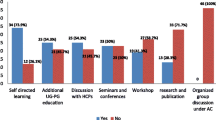Abstract
Objective The main objective of this study was to offer an insight on the issue of continuing education (CE) in the UAE and to determine the type and format of CE pharmacists in this country prefer to attend and consider most effective. Methods A multi-theme survey was developed to find the reasons pharmacists choose to attend different CE programs, the survey assessed continuing education needs and preferences of pharmacists. Survey items included the types of formats and topics pharmacists prefer to attend and think are most useful to enhance their knowledge and skill. Finally the survey explored some barriers pharmacists conceive as such to attending effective CE. Results One hundred thirty-two surveys were included in this study, the vast majority of the participants were bachelor’s degree holders who were 40 years and younger. The participant’s main types of employment were marketing and hospital practice. Pharmacists’ preferences as for the format and topic type for programs they would like to attend were identified and compared to other practice settings. Barriers to attending effective CE programs were also elicited. Conclusion: Interactive workshops were recognized as the most favorable format for CE in this study, computer and internet-based formats were also ranked highly by participants followed by live-in person and printed material-based programs. Topics covering innovations in pharmacy practice and disease management were at the top of priorities for pharmacists who would also like to see more certificate programs be offered to them.
Similar content being viewed by others
References
Accreditation Council for Pharmacy Education. Definition of continuing education. Available at http://www.acpe-accredit.org/pdf/CEDefinition04.pdf. Accessed 10 March 2008.
International Pharmaceutical Federation (FIP) report “Global Pharmacist Workforce and Migration”. Available at http://www.fip.org/www/index.php?page=rfh_datacollection. Accessed 1 June 2008.
Dubai Department of Health and Medical Services. Available at http://web.dohms.gov.ae/medlib/cme/cme.htm. Accessed 1 June 2008.
Abu-Dhabi General Authority on Health Services CE requirements. Available at http://www.haad.ae/haad/tabid/58/Mid/417/ItemID/51/ctl/Details/Default.aspx. Accessed 1 March 2008.
Abu Dhabi pharmacists to undergo training program (news from the Health Authority of Abu-Dhabi). Available at http://archive.gulfnews.com/nation/Health/10228712.html. Accessed July, 2008.
Maio V, Belazi D, Goldfarb N, Phillips A, Crawford A. Use and effectiveness of pharmacy continuing-education materials. Am J Health Syst Pharm. 2003;60(16):1644–9.
Scott VG, Amonkar MM, Madhavan SS. Pharmacists’ preferences for continuing education and certificate programs. Ann Pharmacother. 2001;35:289–99.
Hale KM, Altschuld JW, Gerald MC, Reuning RH. Assessment and comparison of interest in, commitment to, and perceived value of post-baccalaureate certificate and doctor of pharmacy programs. Am J Pharm Educ. 1989;53:121–6.
Adamcik BA, Oppenheimer PR, Brown JF, Eagen PA, Denson TA. Attitudes and needs of pharmacists relevant to traditional and practice-based continuing education. Am J Pharm Educ. 1985;49:22–30.
Marriott JL, Duncan GJ, Mc Namara KP. Barriers to pharmacist participation in continuing education in Australia. Pharm Educ. 2007;7(1):11–7.
University of Oklahoma College of Pharmacy Continuing Education Survey. Available at http://pharmacy.ouhsc.edu/downloads/enews/2003/vol3_issue4_0228.pdf. Accessed 25 February 25 2007.
Dubai International Pharmaceuticals & Technologies Conference at http://www.duphat.ae/.
The Annual Ministry of Health Statistical Report. Available at http://www.moh.gov.ae/en/default.aspx. Accessed 13 December 2007.
Promotion via medical representatives in Saudi Arabia and the UAE in the Merlin Healthcare Research Report. Available at http://www.zawya.com/story.cfm/sidZAWYA20040329112513/Healthcare?pass=1. Accessed 13 December 2007.
LeRoy Ml, De Muth Je. Attitudes and policies about continuing education among Wisconsin hospital pharmacy directors. Am J Hosp Pharm. 1987; 44(6):1381–1385.
Fjortoft N, Schwartz A. Evaluation of a pharmacy continuing education program: long-term learning outcomes and changes in practice behaviors. Am J Pharm Educ. 2003;67(2) Article 35.
Hasan, S, Yehia E, Zorob R, Alrijal M, Saleh I, Alkitbi L. Evaluation of community pharmacist continuing education in the UAE. Tanmia Paper & Poster Presentations, Sharjah University. May 26, 2008.
Driesen A, Leemans L, Baert H, Laekeman G. Flemish community pharmacists’ motivation and views related to continuing education. Pharm World Sci. 2005;27(6):447–52.
Cordero L, Cadavid MI, Fernández-Llimós F, Díaz C, Sanz F, Loza MI. Continuing education and community pharmacists in Galicia: a study of opinions. Pharm World Sci. 2004;26:173–7.
Hoyle S, Mottram DR, Williamson PM, Hart A. A study into how community pharmacists update their pharmaceutical knowledge. Pharm J. 1990;245:E8–9.
Holland RW, Nimo CM. Transitions, part 1: beyond pharmaceutical care. Am J Health Syst Pharm. 1999;56:1758–64.
Davis D, O’Brien M, Freemantle N, Wolf F, Mazmanian P, Taylor-Vaiscy A. Impact of formal continuing medical education. JAMA. 1999;282:867–74.
Davis D. Does CME work? An analysis of the effect of educational activities on physician performance or health care outcomes. Int J Psych Med. 1998;28:21–39.
Nona DA, Kenny R, Johnson DK. The effectiveness of continuing education as reflected in the literature of the health professions. Am J Pharm Educ. 1988;52:111–7.
Acknowledgments
A special thank you goes to the second and third-year pharmacy students who helped in the distribution and collection of the surveys. The role of the following pharmacists who participated in the piloting phase of the study is much appreciated: Nidhal Baqi, Abdullah Kindi, Fawziyya Sharhan, Zeinab Khalil, and Mohammed Abu-Elkhair.
Funding
None.
Conflicts of interest statement
The author declares no conflicts of interest.
Author information
Authors and Affiliations
Corresponding author
Appendix A
Rights and permissions
About this article
Cite this article
Hasan, S. Continuing education needs assessment of pharmacists in the United Arab Emirates. Pharm World Sci 31, 670–676 (2009). https://doi.org/10.1007/s11096-009-9330-z
Received:
Accepted:
Published:
Issue Date:
DOI: https://doi.org/10.1007/s11096-009-9330-z




